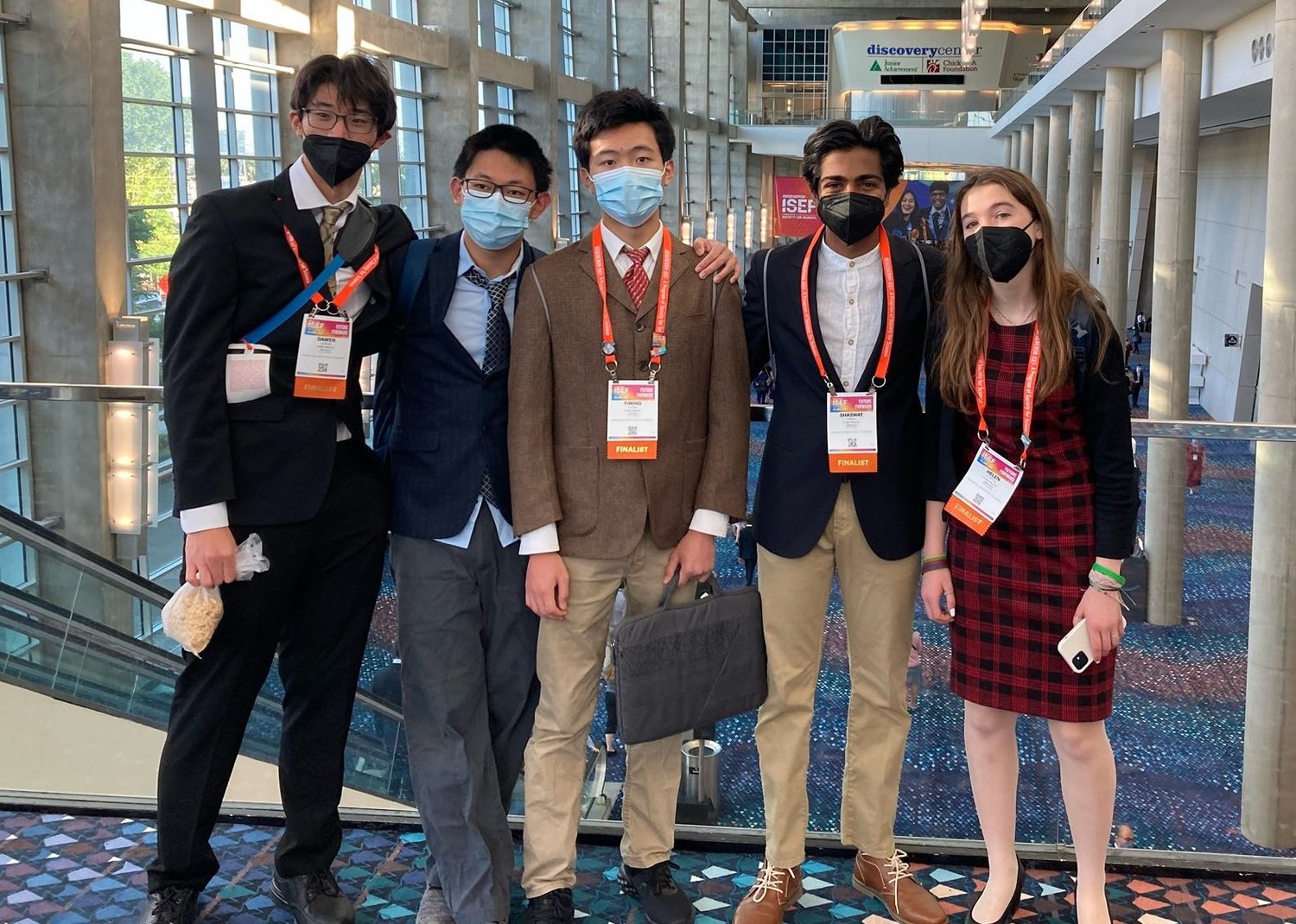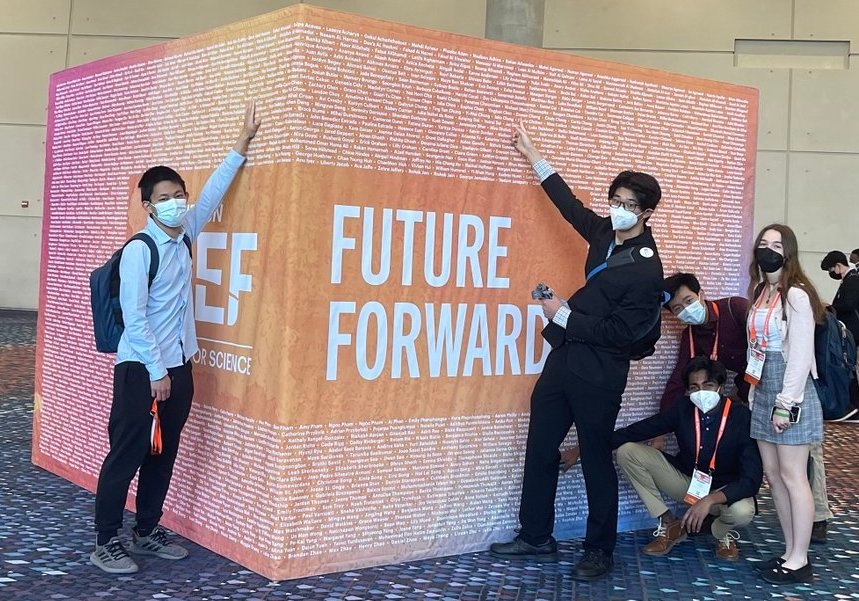BHS science standouts place at premier science fair
Two teams of BHS students place in top-five at international science fair
Barrington High School made history this year, as two teams of BHS students won "Best In Fair” awards at the RI Science and Engineering Fair and earned the right to share their projects at the …
This item is available in full to subscribers.
Please log in to continue |
Register to post eventsIf you'd like to post an event to our calendar, you can create a free account by clicking here. Note that free accounts do not have access to our subscriber-only content. |
Day pass subscribers
Are you a day pass subscriber who needs to log in? Click here to continue.
BHS science standouts place at premier science fair
Two teams of BHS students place in top-five at international science fair
Barrington High School made history this year, as two teams of BHS students won "Best In Fair” awards at the RI Science and Engineering Fair and earned the right to share their projects at the Regeneron International Science and Engineering Fair held in Atlanta, Ga.
Maybe even more impressive was the fact that both Barrington High School teams placed in the top-five of their respective categories at the Regeneron International Science and Engineering Fair, which is considered the premier high school science fair in the world.
The accomplishment was not lost on Barrington High School Science Department Chair Diana Siliezar-Shields.
“We were trying to think back to when this happened before, and we can’t remember, definitely not for Barrington. But at the state level … this is very unique, and we were so excited,” she said.
“I’ve never had two teams, at the international level, and both teams place. This is amazing.”
The team of Yike “Patrick” Chen, Dawen Cheng and Yiming “David” Xiong entered their project titled “Dangerous Occasion Monitoring and Management System” and finished second in the Embedded Systems category.
“… our project is geared toward underdeveloped countries where workplace regulations are less-stringent and workers are working in very dangerous environments,” Dawen said, offering the example of silver miners in Indonesia. “What our system does is we create several layers of protection through things like location tracking, biometric sensor packages and fall detection algorithms using machine learning all at a very low cost, in a system that’s cheap and easily installable.
“What we have is essentially a system of hubs and wristbands. Each worker would wear a wristband, which again, is very cheap to manufacture, using real time data. It literally costs $19 to make.”
Patrick added: “We’re creating a technology and hardware at the same time.”
David said their project was the culmination of many smaller projects put together.
“That’s really what made it stand out in the fair,” he said.
The team of Helen Copple and Shaswat Singh entered their project “Evaluating the Migration of Glioblastoma Stem Cells in vitro Towards a Chemoattractant Gradient” and finished fourth in the Biomedical and Health Sciences category.
Helen and Shawswat worked with a Phd student at Brown University (Yusuke Suita) on a potential new therapy to battle an aggressive form of cancer, glioblastoma multiform.
“Our project was supporting the efficacy of a cutting edge therapy for glioblastoma multiform, which is one of the most lethal and aggressive brain cancers,” Shaswat said. “It’s called the Gliotrap and it works to aggregate disseminating glioblastoma stem cells, which are stems cells that are on the outside edge of the tumor. These stem cells evade resection and move to other parts of the brain. Therapy was aimed at aggregating and localizing these stem cells so that they could be targeted.”
Helen added: “… basically the Gliotrap is still in development, it hasn’t run through clinical trials yet. There’s currently in vitro testing. And we were able to work on the in vitro testing on the efficacy of this therapy. We wanted to confirm the mechanism behind the Gliotrap, not the Gliotrap itself… We were able to perform three different experiments to confirm that the Gliotrap is viable in this environment. After these experimentations, we used a prototype device that resembled an environment like you’d see in the brain, and we were able to seed 100,000 cells, which is basically like a mini-tumor and replicate an environment like you’d see in the brain, and the Gliotrap still worked.”
‘Technical genius’
Patrick, David and Dawen have known each other for years, but the three Barrington High School students got to know each other a lot better while working on their science project.
In fact, for months, the three students actually lived in each other’s homes.
“During the last three months preparing for the science fair I moved in with him,” David said, gesturing toward Patrick. “And we worked on this project every single day.”
Patrick nodded.
“My house looks like a startup right now,” he said.
Dawen added: “We all lived together (at my house) for a month and then my dad is like, ‘All right, this is too much.’ Then David went to Patrick’s house.”
David, Patrick and Dawen logged more than 450 hours working on their project. David and Dawen were quick to point to Patrick as the central figure in the project. They said he led the charge in writing more than one million lines of code for the project.
“He’s a technical genius,” Dawen said, of Patrick. “Another thing about our project is that we didn’t have a mentor.”
“I am the mentor,” Patrick added.
Patrick Chen moved to the United States from China three years ago, looking for opportunity. The 18-year-old found it at Barrington High School. He has thrived in classes and the extra-curricular activities, such as the BHS Science Olympiad team.
“And the reason I came here is for these kinds of stuff. I came here for (science fair), to go my own way. That’s not how it works outside the United States,” he said.
“For me personally, the fair taught me … the ability to radiate the knowledge I have to other people around me, like my best friends … it’s just different. It makes me happy. We had our fights, but it was an amazing experience.”
Dawen said he the overall experience of working on a science fair project and then entering it in the competitions offered an opportunity to learn how to deal with pressure.
“That’s something that I’ve experienced to some degree with Science Olympiad and tennis and all of the activities that I do, but the International Science and Engineering Fair was a culmination of months of pressure,” Dawen said. “If you think about yourself as a piece of carbon, when the pressure comes you’re either going to break or you’re going to crystalize and become a diamond. When that pressure gets to you, that’s what separates people. Some people will harden and toughen up. Some people will shatter. If you’re the one that shatters, you have to figure out a way to regroup, rebuild yourself and keep going.
“We had our struggles. We also had our fights occasionally. I think that we came away from the International Science and Engineering Fair with a better understanding of ourselves, of the world, of the scientific world around.”
David added: “My biggest takeaway is everything I’ve learned from him (Patrick), because as we worked on this project, it was a learn as you go experience. And then learning to weave all the components together was something entirely different. We had to pull in so many different fields, learning everything at once.”
All three students reveled in the opportunity to meet other students from around the world.
“We met so many amazing people,” Dawen said. “For example, Shaswat was able to reconnect with the delegation from India… I was able to meet with the delegation from Taiwan. My parents are from Taiwan. We even met kids from say, like, Kentucky. It was just an amazing experience to be able to see and to talk with every single other person and you finally see — even though there are brilliant people at Barrington High School, you feel that there’s still a difference in, say, interests. People are very interested in sports, and it’s not that we’re not, it’s that we’re interested in the things that the kids at the International Science and Engineering Fair just understood.”
‘Taste of the real world’
Shaswat and Helen began their work at Brown University’s Tapinos Lab in November, traveling up to Providence three or four days a week to meet with their mentor, Yusuke Suita.
The work, Shaswat said, was an extremely positive experience.
“I would certainly rate it the best experience I’ve had in high school so far. Just the whole experience of conducting the research at the lab, learning so much about actual practical applications of what I learned in class, in AP Bio, actually applying that, learning so much more, and then going to the International Science and Engineering Fair, meeting all these people from all around the world. Learning about all these interesting things that they’re working on was certainly an experience that I really thoroughly enjoyed,” he said.
“Working at the Tapinos Lab really did broaden my understanding of what I was interested in and this was something that I would look to go further into.”
Helen agreed.
“I feel like growing up in Barrington, people are very academically inclined, but I think it’s a bit of isolated culture in Barrington,” she said. “It’s different than other schools in urban environments. I think working on this project, you meet so many different people from so many different backgrounds. You first see how lucky we are in Barrington, and how privileged we are. And to meet people from Saudi Arabia, India, Pakistan… Shawswat and I became really close with friends from India and I still FaceTime them. Seeing that there is so much more of a world out there than this small little town was almost liberating in a way. It was like a taste of the real world, and it was very eye-opening.”
Helen also said she treasured the time she spent with Shaswat. Despite arguing at times on their project, the two became close friends.
“Shaws is like, he’s amazing. It’s been so nice to get so close to him,” she said.
Siliezar-Shields, who chaperoned the Barrington High School students on their trip to Atlanta for the Regeneron International Science and Engineering Fair, said she was very proud of all of them.
“For these students, we provide the opportunities and then you let them go and see where they go. And to see their success at the International Science Fair and see their passion and see them really become scientists in their own view of themselves, is something that is unique,” she said. “I think teachers are the only ones who understand how proud, how emotional it is as a teacher. To see someone grow that much…”
Siliezar-Shields wanted to share a special thanks with two individuals from Brown University who have helped with science fair projects in the past: Ece Uzun, Phd, Director of Clinical Bioinformatics, and Alper Uzun, Phd, Associate Professor of Pediatrics.









